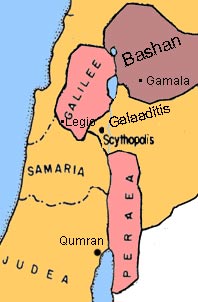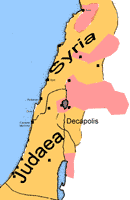JC – Hero of the People
The God who never was becomes a rebel who never rebelled
A ‘life’ conjured up from mystical fantasy, a mass of borrowed quotations, copied story elements and a corpus of self-serving speculation, does not constitute an historical reality. It constitutes a myth, a hero-myth, in essentials no different from the legends of champions that times of crisis called into existence in many cultures. “Jesus Christ Lord and Saviour” is certainly the most convoluted and enduring of such accretions but its fabrication from simple elements is no less apparent than that of any other west Asian salvation god.
A revised ‘rabbinic’ Judaism made an impressive revival in the 2nd-3rd centuries. But by then a heresy called Christianity had been commandeered by gentile pagans who saw opportunity in a hybridised oriental cult with a strong Jewish core.
Rebel with a Sword? Enter the Nazarenes
Judas himself appears to have been a member of a curious family dynasty of rebels who continued to lead a resistance movement at least until the defeat of 70 AD. Certainly, a century of ruthless exploitation by Rome, added to the fearsome exploitation by the priesthood and the Herodian aristocracy, created conditions which made civil war and rebellion inevitable.
Judaism's "Worthless peasants"
The poor, the disabled and the sick were all ritually unclean. Male Jews even had a morning prayer thanking God for “not being made a woman.” Unwelcome in the sanctums of the Temple, those who would not, or could not, fight turned to a simple expedient: a river and a wild guru.
John the Baptist (30s AD)
Where did they get their ideas from?

Jewish Gnosis: Paul's "good news" for the Essenes –
Paul has had a vision. He has seen the anointed one and he now sits at God’s right hand! His death was a redemption (just like that of Adonis, Osiris, Dionysus, et al!) and his followers can look forward to salvation and an eternal life.
Paul finds The Exalted One a name… "Jesus"
How did a dead Essene make it to heaven? This neat trick (by now the Zadokite founder of the Essenes had been dead for 150 years) was achieved by “raising him”, like Elijah, to heaven. God, it seems, had “glorified his servant”, had “exalted” him to his right hand, he had entered or been “assumed” into Heaven. And Paul could agree with the Essenes: in the imminent Last of Days the sinful world would be destroyed utterly and the “brotherhood of the righteous” would inherit the earth.
The War of Light and Darkness
Factional strife ceased only when Titus’s four legions besieged the city for five months in 70 AD but by then the situation had become hopeless. Eventually breaching the formidable walls of the city, the Romans overwhelmed the hungry defenders. The Temple itself was burned to the ground and the city gutted. A few hundred Sicarii/Essene extremists continued resistance further south, in the fortress palace of Massada. But after a three year siege they, too, were defeated. Their mass suicide is renowned.
Location, Location

Pella was the very essence of an Hellenized city. Its ruins are as extensive as Jerash, though not as fully excavated.
However – Yet another void
Sources:
- Israel Shahak, Jewish History, Jewish Religion,The Weight of Three Thousand Years (Pluto, 1997)
- Michael Grant, Herod the Great (McGraw-Hill, 1971)
- Neil Faulkner, Apocalypse-The Great Jewish Revolt Against Rome AD66-73 (Tempus, 2004)
- Tacitus, The Annals of Imperial Rome (Guild, 1990)
- Nigel Rogers, The History & Conquests of Ancient Rome (Access, 2004)
Related Articles


"Prophet on the Mount of Olives"


The Eve of War


